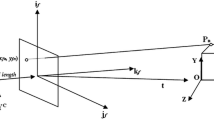Abstract
Instantaneous camera motion estimation is an important research topic in computer vision. Although in theory more than five points uniquely determine the solution in an ideal situation, in practice one can usually obtain better estimates by using more image velocity measurements because of the noise present in the velocity measurements. However, the usefulness of using a large number of observations has never been analyzed in detail. In this paper, we formulate this problem in the statistical estimation framework. We show that under certain noise models, consistency of motion estimation can be established: that is, arbitrarily accurate estimates of motion parameters are possible with more and more observations. This claim does not simply follow from the general consistency result for maximum likelihood estimates. Some experiments will be provided to verify our theory. Our analysis and experiments also indicate that many previously proposed algorithms are inconsistent under even very simple noise models.
Similar content being viewed by others
References
Beauchemin, S. and Barron, J. 1996. The computation of optical flow. ACM Computing Surveys, 27(3):433–467.
Bruss, A. and Horn, B. 1983. Passive navigation. Computer Graphics and Image Processing, 21:3–20.
Gibson, J. 1966. The Senses Considered as Perceptual Systems. Houghton Mifflin: Boston, MA.
Heeger, D.J. and Jepson, A.D. 1992. Subspace methods for recovering rigid motion I: Algorithm and implementation. International Journal of Computer Vision, 7(2):95–118.
Hildreth, E.C. 1992. Recovering heading for visually-guided navigation. Vision Research, 32(6):1177–1192.
Horn, B.K.P. 1987. Motion fields are hardly ever ambiguous. International Journal of Computer Vision, 1:259–274.
Horn, B.K.P. and Weldon, E.J., Jr. 1988. Direct methods for recovering motion. International Journal of Computer Vision, 2:51–76.
Jepson, A.D. and Heeger, D.J. 1991. A fast subspace algorithm for recovering rigid motion. In Proceedings of IEEE Workshop on Visual Motion, Princeton, NJ, pp. 124–131.
Jepson, A.D. and Heeger, D.J. 1993. Linear subspace methods for recovering translation direction. In Spatial Vision in Humans and Robots, L. Harris and M. Jenkin (Eds.). Cambridge University Press: New York, pp. 39–62.
Kanatani, K. 1993. 3-d interpretation of optical flow by renormalization. International Journal of Computer Vision, 11(3):267–282.
Kruppa, E. 1913. Zur ermittlung eines objektes aus zwei perspektiven mit innerer orientierung. Sitz.-Ber. Akad. Wiss., Wien, Math. Naturw. Kl., Abt. IIa., 122:1939–1948.
Lucas, B. and Kanade, T. 1981. An iterative image registration technique with an application to stereo vision. IJCAI.
MacLean, W.J., Jepson, A.D., and Frecker, R.C. 1994. Recovery of egomotion and segmentation of independent object motion using the em algorithm. In Proceedings of the 5th British Machine Vision Conference, York, UK, pp. 13–16.
Matthies, L., Kanade, T., and Szeliski, R. 1989. Kalman filter-based algorithms for estimating depth from image sequences. International Journal of Computer Vision, 3(3):209–236.
Maybank, S. 1985. The angular velocity associated with the angular flowfield arising from motion through a rigid environment. In Proceedings of the Royal Society of London, A-401:317–326.
Moravec, H.P. 1977. Towards automatic visual obstacle avoidance. In Proceedings of the 5th International Joint Conference on Artificial Intelligence, Cambridge, MA, p. 584.
Nalwa, V.S. 1993. A Guided Tour of Computer Vision. Addison-Wesley: Reading, MA.
Negahdaripour, S. 1989. Critical surface pairs and triplets. International Journal of Computer Vision, 3:293–312.
Negahdaripour, S. and Horn, B.K.P. 1987. Direct passive navigation. IEEE Transactions on Pattern Analysis and Machine Intelligence, 9(1):168–176.
Prazdny, K. 1983. On the information in optical flows. Computer Graphics and Image Processing, 22:239–259.
Rao, C.R. 1973. Linear Statistical Inference and Its Applications.J. Wiley and Sons: New York, NY.
Rieger, J.H. and Lawton, D.T. 1985. Processing differential image motion. Journal of the Optical Society of America, A 2:254–360.
Shi, J. and Tomasi, C. 1994. Good features to track. In Proceedings of the IEEE Conference on Computer Vision and Pattern Recognition (CVPR94), Seattle, WA, pp. 593–600.
Trucco, E. and Verri, A. 1998. Introductory Techniques for 3-D Computer Vision. Prentice Hall: Upper Saddle River, NJ.
Verri, A. and Poggio, T. 1989. Motion field and optical flow: Qualitative properties. IEEE Transactions on Pattern Analysis and Machine Intelligence, 11(5):490–498.
Weng, J., Ahuja, N., and Huang, T. 1993. Optimal motion and structure estimation. IEEE Transactions on Pattern Analysis and Machine Intelligence, 15(9):864–884.
Zhang, J. 1999. Computing camera heading: A study. Ph.D. Thesis, Stanford University.
Zhang, T. and Tomasi, C. 1999. Fast, robust, and consistent camera motion estimation. In Proc. CVPR 99, vol. 1, pp. 164–170.
Zhuang, X., Huang, T., Ahuja, N., and Haralick, R. 1988. A simplified linear optic flow-motion algorithm. Computer Vision, Graphics, and Image Processing, 42(3):334–344.
Author information
Authors and Affiliations
Rights and permissions
About this article
Cite this article
Zhang, T., Tomasi, C. On the Consistency of Instantaneous Rigid Motion Estimation. International Journal of Computer Vision 46, 51–79 (2002). https://doi.org/10.1023/A:1013248231976
Issue Date:
DOI: https://doi.org/10.1023/A:1013248231976




